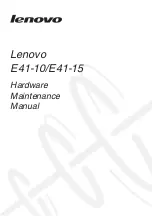
System Introduction
1-27
Table 1-33
Hibernation Mode Conditions and Descriptions
Condition
Description
The condition to
enter Hibernation
Mode
There are two necessary conditions for the computer to enter standby mode:
•
Heuristic Power Management Mode must be set to [ENABLED].
•
System Sleep State must be set to [HIBERNATION].
•
The hibernation file created by Sleep Manager must be present and valid.
In this situation, the following are ways to enter hibernation mode:
•
Pressing the sleep hot key Fn-F7
•
“Hard Disk Drive” is not [Disabled] in System Security of BIOS SETUP.
•
“Hard Disk 0” is not [None] in Basic System Configuration of BIOS SETUP.
•
If the waiting time determined by the computer’s HPM unit elapses without any
system activity.
•
If a battery low condition takes place, the computer enters hibernation mode in
about three minutes. The Sleep Upon Battery-low parameter in Setup must be
set to [ENABLED].
•
Invoked by the operating system power saving modes
The condition of
Hibernation Mode
•
Except the RTC, KB controller and power switch, all the system components are
off.
The condition back
to On Mode
•
Pressing the power switch.
•
Resume Timer matched
DISPLAY STANDBY MODE
Screen activity is determined by the keyboard, the built-in touchpad, and an external PS/2 pointing
device. If these devices are idle for the period determined by the computer’s HPM unit, the display
shuts off until you press a key or move the touchpad or external mouse.
Table 1-34
Display Standby Mode Conditions and Descriptions
Condition
Description
The condition to enter
Display Standby Mode
•
Pointing device is idle until Display Standby Timer times-out or LCD cover
is closed.
The condition of
Display Standby Mode
•
All the system components are on except LCD backlight and CRT
horizontal frequency output (if CRT is connected)
The condition back to
On Mode
•
Any keystroke (Internal KB or External KB)
•
Pointing device activity
The VGA BIOS should support DPMS (Desktop Power Management System) for
the standby and hibernation mode function call. When the Display Standby Timer
expires, the system BIOS will execute the DPMS service routines.
Summary of Contents for 390 Series
Page 15: ...System Introduction 1 3 Figure 1 2 PCB No 96183 1A Mainboard Layout Bottom ...
Page 96: ...2 50 Service Guide 2 3 3 Pin Configuration Figure 2 4 FDC37C67 TQFP Pin Diagram ...
Page 97: ...Major Chips Description 2 51 Figure 2 5 FDC37C67 QFP Pin Diagram ...
Page 102: ...2 56 Service Guide 2 3 6 Block Diagram Figure 2 6 FDC37C67 Block Diagram ...
Page 126: ...2 80 Service Guide 2 5 4 1 Functional Block Diagram Figure 2 10 M38813 Block Diagram ...
Page 128: ...2 82 Service Guide 2 6 2 Pin Diagram Figure 2 11 YMF715 Block Diagram ...
Page 168: ......
Page 169: ......
Page 170: ......
Page 171: ......
Page 172: ......
Page 173: ......
















































